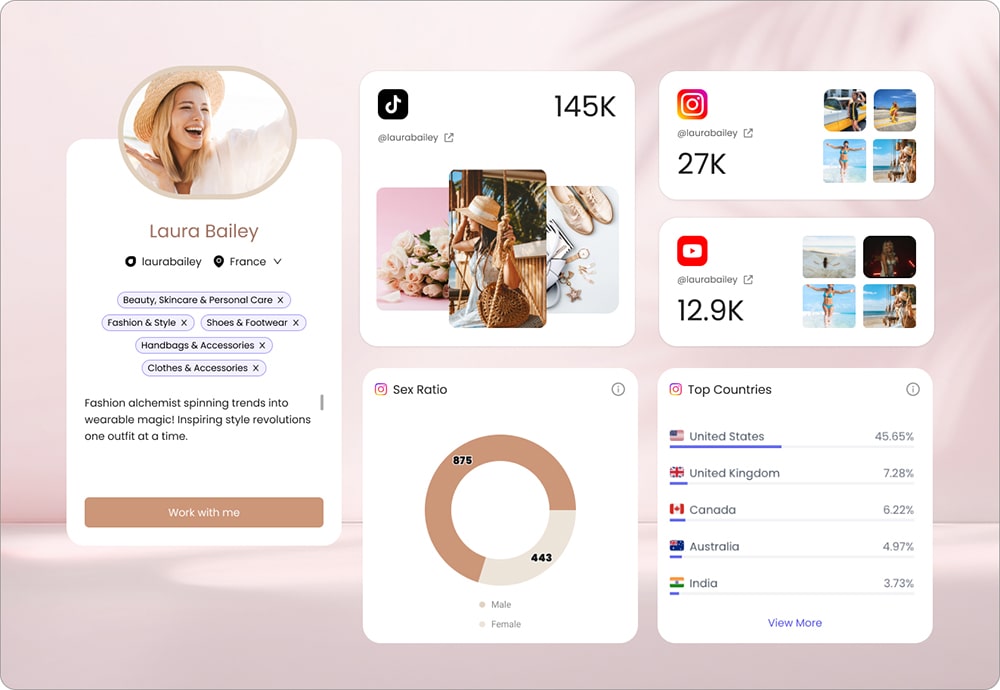In the fast-paced digital landscape of today, one thing is certain: content is still king, and it is unlikely to change in 2024. That’s why for all the influencers and content creators out there, the ability to plan and execute a robust content strategy is not just a skill but a necessity for success and growth. From understanding the pulse of your audience to aligning your content with your authentic brand values, every step is crucial in carving out your place in the digital world, and a properly structured content plan can help you with this significantly.
To help you with this, we’ve decided to craft a guide that explores what content planning is and how you can use it to guide your work, and which will hopefully serve as your compass, helping you navigate through the intricacies of content creation, scheduling, and optimization. So, without further ado, let’s dive into the world of content planning!
What Is Content Planning In Digital Marketing?
So, what is content planning? Before answering this, let’s look at why content planning is useful.
You can think of your content plan as a framework for your content. While you don’t need to have every single post planned in detail, your content plan can act as a reference point for you on what you should work on. This will then ensure that you don’t run out of things to post, as well as don’t post content that is not reflective of you and that your audience won’t enjoy. Having a content plan always keeps you on track, even on the days when you don’t feel like posting or don’t know what to post.
Now that you know how content planning can help you with your marketing efforts, let’s take a look at what it is exactly.
At its core, content planning begins with defining clear, measurable goals. Your content plan is the structure that defines which content initiatives you need to execute and how; it is also what will guide you through creating and posting every piece of content, and help you navigate through content-related challenges and lack of inspiration. As part of your influencer marketing efforts, your content plan should ideally answer the following questions:
- What kind of content is going to be created?
- When will it be published?
- Where will it be posted?
- Why are you posting that piece of content?
- How will you be analyzing the performance and results?
We will look into what should be included in your content plan later in the article.
What Are The Elements Of Content Planning?

Content planning is a comprehensive and detailed process. And as such, it involves several key elements you need to include to ensure it aligns with your overall promotional goals and that it can help you to achieve the objectives of your influencer efforts. Below, we’ll look into some of the most important elements of content planning.
Objectives and Goals
When working on your content plan, the first element is to establish a clear objective for the content that you are posting. Ask yourself what it is that you want to achieve with your content. The goals can range from raising awareness about you as a content creator and follower engagement to sharing a promotion you’ve been working on recently. Your goals should align with how you see your growth and be reflected in your content.
Content Audit And Analysis
Next up in the process of content plan creation is content audit. Before creating new content, it’s often helpful to conduct an audit of existing content. This involves reviewing what you have, assessing its performance, and identifying gaps. A content audit helps in understanding what works, what doesn’t, and what can be improved or repurposed.
Editorial Calendar Creation
Your editorial calendar is where you plan and schedule your content, and it’s a crucial part of your content plan. It can help you greatly with organizing content creation and publication across different platforms, ensuring a consistent and strategic approach. You don’t need to have every single post of the year in there! As an influencer, you may often get in touch with brands and create partnership posts, so don’t think of an editorial calendar as something set in stone, as you might need to change it frequently. However, it’s a great way to make sure you have some posts and content planned and lined up in advance.
Resource Allocation and Management
To create and distribute content, you need resources, from financial (buy props and materials needed for the shooting, distribute your content) to human resources (people to help you shoot your content). While this is something that cannot be estimated 100% accurately, when creating your editorial calendar and planning your posts, take some time to estimate what resources you will need for the content to come to life.
Content Curation
The last step of your content plan is the curation of the content. This involves the writing of the script (if it’s a video), shooting the material, writing the caption, etc., depending on your content format.
What Should Be Included In A Content Plan?

As you can see, a content plan is a detailed document that outlines the specifics of your content marketing efforts and can help you greatly in achieving your goals. Now that you know what some of the key elements of a content plan are, let’s take a more detailed look into what should be included in a comprehensive content plan in addition to the elements discussed above.
Target Audience Analysis
Target audience analysis is one element that should be present at all stages of your content planning and content strategy (more on this later) effort. Depending on your work over the last year, your target audience might have changed, and so might their interests. Therefore, when working on your content plan for 2024, you need to include a detailed description of your target audience. This should cover demographics, interests, pain points, and online behavior that you observed and measured. Understanding your audience is crucial for creating content that resonates with them.
Content Themes and Topics
Your editorial calendar will contain your final posts, but it will be a work in progress. To guide it, you need a more general framework, and here is where the planning of content themes and topics comes in. At this stage, outline the key themes or topics that your content will cover. These should align with your expertise and the interests of your target audience, as well as the interests and pain points you observed, as mentioned earlier.
Content Types and Formats
Next up is the planning of content types and formats. Here, you need to decide on the types of content you will create. The “ideal” post format will vary depending on the topic, the platform you use more frequently, as well as your resources, and can vary from social media posts to blog posts, YouTube video essays, and even podcasts. The choice should be based on what is most effective for your audience and goals, based on your earlier content analysis.
Content Creation Guidelines
The importance of content creation guidelines shouldn’t be underestimated, so make sure to establish them. These will help you to maintain consistency in your tone of voice, written, spoken, and visual style, as well as the quality of your content. Your content guidelines might include your brand voice, language style, branding (visual style guidelines, set of branded hashtags), and anything else you consider to be part of your influencer brand.
Measurement and Analytics
Lastly, you need to know how your content is performing. For this, identify key performance indicators (KPIs) and social media metrics to measure the effectiveness of your content. This section should outline how you will track performance, the key metrics you will consider (engagement rate, CTR, follower count), and the tools you will use to measure and analyze this information.
What Is The Difference Between Content Plan And Content Strategy?
If you use content planning and content strategy interchangeably, you are not alone. It’s a pretty common misconception and one that should be avoided. These two terms play distinct, yet complementary roles in the world of content marketing, including influencer marketing, and understanding the nuanced difference between them is crucial for managing and delivering your content effectively.
So, what is the difference? Let’s start with content strategy. Your content strategy is the high-level vision that will underpin your content development efforts to align them with your goals and objectives. Think of it as the foundation of all your content efforts: it defines why you are creating the content, who are you creating it for, who and how exactly it will be helping, and how it will distinguish itself. Your content strategy also delves into your existing and potential future audience, analyzing its needs and interests, dictates what your messaging should be, and what brand voice it would be strategically better to adopt to maximize results. In essence, it’s the guiding philosophy of your objectives as a content creator and the framework that will guide your actions in the digital world, more or less.
In contrast, your content plan is where your content strategy takes a practical turn: it’s the operational side of your content strategy, outlining the specificities of how the content should be created and distributed. It deals with the details of what content will be created, when and how it will be created, what you need for it, how to find the resources needed for the content creation process, and where it will be published. The content plan is the nuts and bolts of your content strategy, detailing content formats, topics, schedules, and distribution channels. You can think of it as the framework dealing with the day-to-day execution of content creation, ensuring that every piece of content aligns with your overall content strategy.
In essence, while the content strategy sets the stage, laying out the “why” and “what” of your content efforts, the content plan addresses the “how” and “when.” It’s the transformation of your strategy into actionable steps and finally, bringing your vision to life.
How to Create a Content Plan?
Now that you know what a content plan is, what it should contain, and how it differs from a content strategy, let’s move to the more practical side of content planning, and take a look at how exactly you can make a content plan. As you may have guessed, it involves a series of steps designed to align your content with your goals and the needs of your audience. Below is a step-by-step guide on how to create an effective content plan.
Step 1: Define Your Goals
This may come as no surprise, but the first step should always be clearly defining your goals. Start by clearly outlining what you want to achieve with your content. Goals can range from increasing awareness about your personal brand, generating leads to your website/pages or websites of your partners, and boosting engagement to driving sales. Make sure that these goals are SMART:
- Specific
- Measurable
- Achievable
- Relevant
- Time-bound
Step 2. Understand Your Audience
To craft an effective content strategy, you need to understand your audience deeply. If you’ve already worked on a content strategy or a content plan before, you may want to take the prior research into account. Make sure to revisit it to see if your prior knowledge is still relevant. If this is your first time working on a content plan, or you don’t have a very clear idea about your audience, conduct audience research to learn about their preferences, challenges, and behavior. This can be through built-in analytics tools of social media platforms or analysis of other creators in your niche and their audiences. Create audience personas to represent different segments of your target market. This step is vital to ensure that your content resonates with your audience.
Step 3. Conduct a Content Audit
If you have existing content, do a content audit to determine what’s working and what’s not. Look for gaps in your current content and identify opportunities for new content. This will help you understand what type of content engages your audience the most. This is also an important step to understand your audience and their preferences, contributing to Step 2.
Step 4. Plan Your Content Types
This is the step where you decide on the key themes and topics your content will cover. Determine which types of content you will create. Will it be blog posts, videos, podcasts, infographics, social media updates, or something else? Your choice should depend on what is most effective for your audience and goals. It should also align with your values and the key messages you want to convey.
Step 5. Create an Editorial Calendar
Develop an editorial calendar that outlines what content will be created, when it will be published, and how you will be creating it. As mentioned earlier, your editorial calendar doesn’t need to contain every single post of the year it is during the first week of the year. What it should include is deadlines for drafts, editing, and publication. It can also highlight holidays or specific days of the year posting is especially important (Thanksgiving post, Christmas post, etc.) It helps you organize and manage your content production process more efficiently, without a rush and chaos.
Step 6. Plan for Distribution and Promotion
Where you share your content is just as important as the content itself, even more so. Take some time to decide where you will be sharing and promoting your content. This could include your website, social media channels, email newsletters, and other platforms. Do you have multiple social media channels? Will you be sharing the same thing on each platform, or crafting different pieces for TikTok and Instagram? Knowing this can help you organize the content creation process better later on.
Step 7: Calculate The Resources
Detail the resources (human, financial, and technological) needed to execute the content plan. This should include content creation tools you may potentially need, roles of team members, if you work in a team, as well as the budget requirements. Your budget can also guide your content planning: if you don’t have a budget for a film crew, maybe a professional short film should wait for a bit.
Step 8: Measure and Adjust
Lastly, set up a system for measuring the performance of your content. Determine how you will track engagement, reach, and conversion metrics, and what tools you will use to do it. Plan on using paid platforms? Add the costs to your budget. Make sure to regularly review these metrics and adjust your content plan based on what you learn.
Remember, a content plan is not set in stone. It should be flexible and evolve based on feedback, performance data, and changes in the digital environment and the trends in your niche. Regularly revisiting and updating your content plan is key to maintaining its effectiveness.
Content Plan Template
If this is your first time creating a content plan, it might seem a bit overwhelming. To help you with this, and simplify the process even further, we’ve made a content plan template you can use as a starting point as you start planning your content. You can access the template through this link. Make a copy to save it, and then edit and customize it, and add and delete rows to meet your specific needs. Remember to be flexible about it and update it regularly as you gather audience and performance data, and get involved with brand partnerships.
FAQ
There is no such thing as a perfect content strategy: whether a strategy is good will depend only on your goals and needs. Therefore, good content strategies are the ones that effectively meet the objectives they have set out to achieve. They start with a clear understanding of the target audience and are built around delivering value to that audience. They involve a mix of content types and channels best suited to the brand and audience. Good strategies are also flexible and adaptable, incorporating feedback and analytics to refine content over time. They emphasize quality, relevance, and consistency, ensuring that the content not only attracts but also retains audience interest.
To create an influencer content plan, start by defining clear goals that align with your personal brand and audience interests. Understand your audience deeply to create content that resonates with them. Develop a content strategy that reflects your unique style and voice. Decide on the types of content (like social media posts, blog posts on your website, long-form videos) that will most effectively engage your audience. Create an editorial calendar to schedule content production and publication. Allocate the necessary resources, including time for content creation and tools for content management. Finally, be flexible and ready to adapt your plan based on audience feedback and content performance.
A content plan is essential because it provides a structured approach to your content creation and distribution. It aligns your content with the objectives of your influencer efforts and ensures consistency in messaging. By having a plan, you can effectively target your audience with relevant and engaging content, manage your resources more efficiently, and measure the impact of your content.
Reviewed By Rem Darbinyan
Revolutionizing industries with AI, Rem Darbinyan is the CEO of ViralMango and an entrepreneur, AI expert, and influencer marketing strategist.



